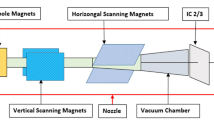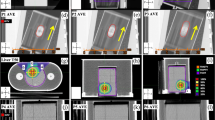Abstract
The purpose of this study was to investigate the proton beam matching for a multi-room ProteusPLUS pencil beam scanning (PBS) proton therapy system and quantify the agreement among three beam-matched treatment rooms (GTR1, GTR2, and GTR3). In-air spot size measurements were acquired using a 2D scintillation detector at various gantry angles. Range and absolute dose measurements were performed in water at gantry angle 0°. Patient-specific quality assurance (QA) plans of four different disease sites (brain, mediastinum, sacrum, and prostate) and machine QA fields with uniform dose were delivered for various beam conditions. The results from GTR1 were considered as reference values. The average difference in spot sizes between GTR2 and GTR1 was − 0.3% ± 2.2% (range, − 5.9 to 5.8%). For GTR3 vs. GTR1, the average difference in spot sizes was 0.6% ± 1.7% (range, − 4.8 to 4.6%). The spot symmetry was found to be ≤ 4.4%. For proton range, the difference among three rooms was within ± 0.5 mm. On average, the difference in absolute dose was − 0.1 ± 0.7% (range, − 1.3 to 2.1%) for GTR2 vs. GTR1 and 0.7 ± 0.6% (range, − 0.1 to 2.1%) for GTR3 vs. GTR1. The average gamma passing rate of patient-specific QA measurements (n = 29) was ≥ 98.6%. The average gamma passing rate of machine QA fields was 99.9%. In conclusion, proton beam matching was quantified for three beam-matched rooms of an IBA ProteusPLUS system with a PBS dedicated nozzle. It is feasible to match the spot size and absolute dose within ± 5% and ± 2%, respectively. Proton range can be matched within ± 0.5 mm.








Similar content being viewed by others
References
Sjöström D, Bjelkengren U, Ottosson W et al (2009) A beam-matching concept for medical linear accelerators. Acta Oncol 48(2):192–200
Hrbacek J, Depuydt T, Nulens A et al (2007) Quantitative evaluation of a beam-matching procedure using one-dimensional gamma analysis. Med Phys 34(7):2917–2927
Sarkar B, Manikandan A, Nandy M et al (2013) A mathematical approach to beam matching. Br J Radiol 86(1031):20130238
Zheng Y, Ramirez E, Mascia A et al (2011) Commissioning of output factors for uniform scanning proton beams. Med Phys 38(4):2299–2306
Rana S, Zeidan O et al (2013) Measurements of lateral penumbra for uniform scanning proton beams under various beam delivery conditions and comparison to the XiO treatment planning system. Med Phys 40(9):091708
Saini J et al (2016) Clinical commissioning of a pencil beam scanning treatment planning system for proton therapy. Int J Part Ther 3:51–60
Lin L, Huang S, Kang M et al (2017) A benchmarking method to evaluate the accuracy of a commercial proton monte carlo pencil beam scanning treatment planning system. J Appl Clin Med Phys 18(2):44–49
Pidikiti R, Patel BC, Maynard MR et al (2018) Commissioning of the world's first compact pencil-beam scanning proton therapy system. J Appl Clin Med Phys 19(1):94–105
Gillin MT, Sahoo N, Bues M et al (2010) Commissioning of the discrete spot scanning proton beam delivery system at the University of Texas M.D. Anderson Cancer Center, Proton Therapy Center, Houston. Med Phys 37(1):154–163
Langner UW, Eley JG, Dong L, Langen K (2017) Comparison of multi-institutional Varian ProBeam pencil beam scanning proton beam commissioning data. J Appl Clin Med Phys 18(3):96–107
Rana S, Samuel EJJ (2019) Measurements of in-air spot size of pencil proton beam for various air gaps in conjunction with a range shifter on a ProteusPLUS PBS dedicated machine and comparison to the proton dose calculation algorithms. Australas Phys Eng Sci Med 42(3):853–862
Parodi K, Mairani A, Brons S et al (2010) The influence of lateral beam profile modifications in scanned proton and carbon ion therapy: a Monte Carlo study. Phys Med Biol 55(17):5169–5187
Lin Y, Clasie B, Lu HM et al (2017) Impacts of gantry angle dependent scanning beam properties on proton PBS treatment. Phys Med Biol 62(2):344–357
Kraan AC, Depauw N, Clasie B et al (2019) Impact of spot size variations on dose in scanned proton beam therapy. Phys Med 57:58–64
Lin L, Ainsley CG, Solberg TD, McDonough JE (2014) Experimental characterization of two-dimensional spot profiles for two proton pencil beam scanning nozzles. Phys Med Biol 59(2):493–504
Rana S, Bennouna J, Samuel EJJ, Gutierrez AN (2019) Development and long-term stability of a comprehensive daily QA program for a modern pencil beam scanning (PBS) proton therapy delivery system. J Appl Clin Med Phys 20(4):29–44
Russo S, Mirandola A, Molinelli S et al (2017) Characterization of a commercial scintillation detector for 2-D dosimetry in scanned proton and carbon ion beams. Phys Med 34:48–54
Bäumer C, Koska B, Lambert J, Timmermann B, Mertens T, Takoukam TP (2015) Evaluation of detectors for acquisition of pristine depth-dose curves in pencil beam scanning. J Appl Clin Med Phys 16(6):151–163
Arjomandy B, Taylor P, Ainsley C, Safai S, Sahoo N, Pankuch M, Farr JB, Yong Park S, Klein E, Flanz J, Yorke ED, Followill D, Kase Y (2019) AAPM task group 224: comprehensive proton therapy machine quality assurance. Med Phys 46(8):e678–e705
Chanrion MA, Ammazzalorso F, Wittig A, Engenhart-Cabillic R, Jelen U (2013) Dosimetric consequences of pencil beam width variations in scanned beam particle therapy. Phys Med Biol 58(12):3979–3993
Acknowledgements
The authors would like to thank Victor Chirinos (medical physics assistant at the Miami Cancer Institute) for assisting us in taking some of the measurements in this study.
Funding
This study does not include any funding.
Author information
Authors and Affiliations
Corresponding author
Ethics declarations
Conflict of interest
All authors declare no relevant conflict of interest.
Ethical approval
This article does not contain any studies with human participants or animals performed by any of the authors.
Additional information
Publisher's Note
Springer Nature remains neutral with regard to jurisdictional claims in published maps and institutional affiliations.
Rights and permissions
About this article
Cite this article
Rana, S., Bennouna, J. Investigating beam matching for multi-room pencil beam scanning proton therapy. Phys Eng Sci Med 43, 1241–1251 (2020). https://doi.org/10.1007/s13246-020-00927-7
Received:
Accepted:
Published:
Issue Date:
DOI: https://doi.org/10.1007/s13246-020-00927-7




